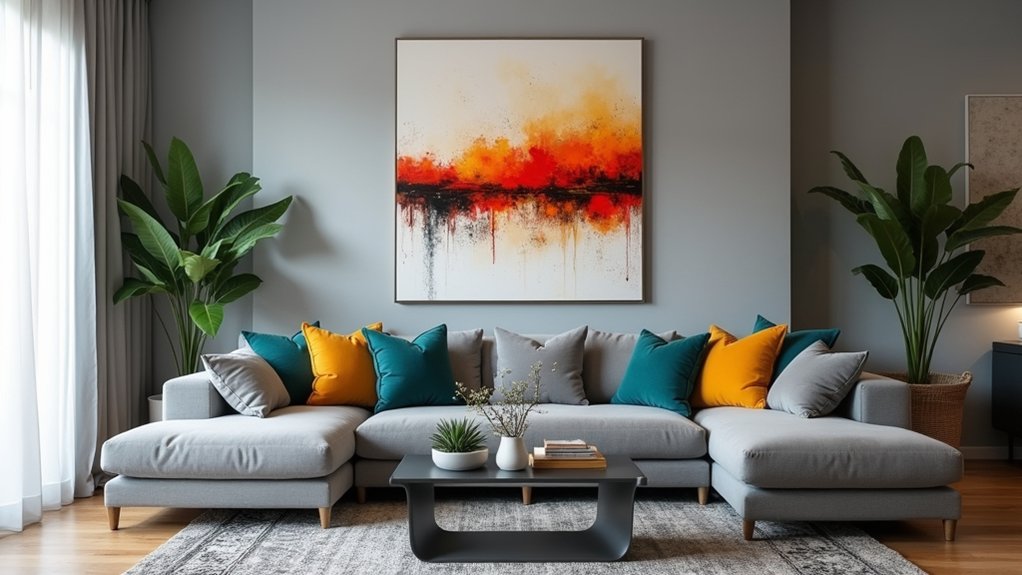
14 Grey Living Room With Color Ideas to Add Energy and Interest
A grey living room gains vibrancy when paired with bold accent colours like citrus yellow, emerald green, or rich plum. Incorporating textural layers—velvet cushions, linen throws, and plush area rugs—introduces depth and tactile interest. Warm lighting and natural materials such as wood, jute, or stone balance grey’s coolness. Metallic and black accents add modern contrast, while botanical elements soften the palette. Strategic colour placement and focal accessories guarantee energy and sophistication, with numerous creative approaches to explore.
Key Takeaways
- Pair grey walls with bold citrus accents like yellow or tangerine to instantly energize the living room.
- Incorporate jewel-toned accessories such as emerald green cushions or plum throws for a rich pop of colour against grey.
- Use natural wood furniture and earthy elements to warm up cool grey tones and add inviting texture.
- Add metallic finishes and black accents for contrast, creating a modern, sophisticated look in a grey living room.
- Layer different grey textiles—velvet, linen, patterned rugs—then swap in colourful decor for easy seasonal updates.
Make Grey Part of a Vibrant Colour Scheme
How can grey serve as the anchor for a vibrant living room palette? Grey living room ideas leverage this neutral as a sophisticated foundation, allowing for bold experimentation with vibrant colour schemes. Warm greys act as a subtle backdrop, amplifying the intensity of jewel-toned elements or popular hues like Mocha Mousse and olive green. Employing the 60-30-10 colour palette rule—60% grey, 30% secondary colour, 10% accent colour—ensures visual appeal and balance. Introducing energetic accent colours, such as citrus yellow, injects energy to a grey environment, preventing monotony. Adding bold pops of color like hot pink or teal can create striking contrasts that energize the space. Seasonal updates, through rotating accent colours or textures, keep the space dynamic and responsive to trends. Ultimately, grey’s adaptability supports layered schemes that combine vibrancy and harmony for maximum design impact.
Incorporate Grey Through Soft Furnishings
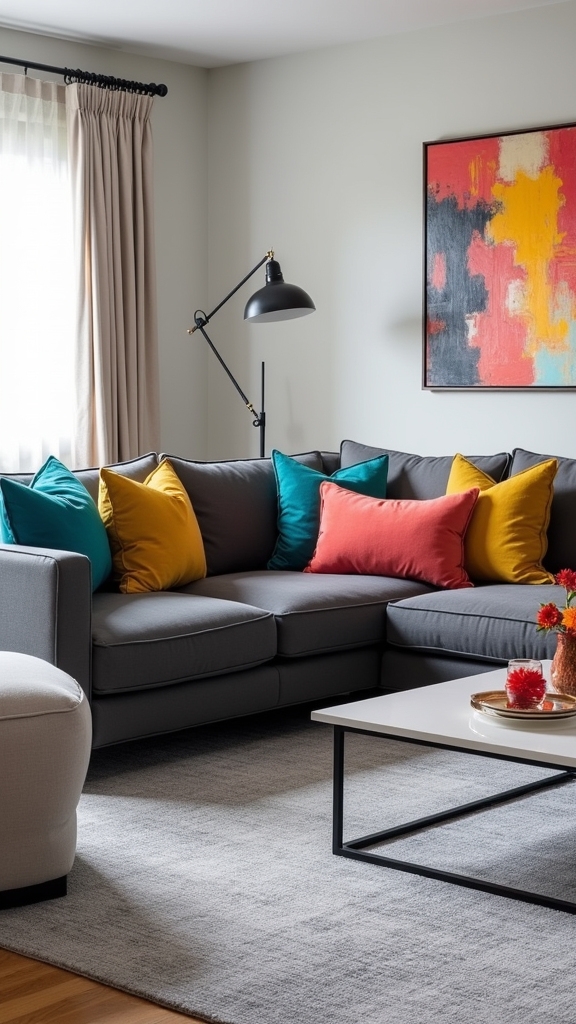
Building on grey’s role as a grounding element in vibrant palettes, integrating this hue through soft furnishings offers both versatility and tactile appeal.
Incorporating grey via cushions, throws, and area rugs introduces depth and texture, supporting a sophisticated aesthetic without overwhelming the space. Layering fabrics such as velvet, linen, and wool in various tones—including warm grey tones—enhances visual interest and cultivates a cozy atmosphere.
Opting for patterned grey textiles injects subtle personality while preserving cohesion within the color scheme. Using area rugs allows for visual delineation of spaces, which is an effective way to define zones for different activities. This method allows for effortless seasonal updates; simply swapping out soft furnishings refreshes the room’s look with minimal disruption.
Pair Grey With Trendy Accent Shades
Introducing jewel tones such as emerald green or rich plum alongside grey establishes a sophisticated palette with compelling depth. For a dynamic contrast, vibrant citrus yellow accents infuse energy and warmth, counterbalancing grey’s inherent coolness. Strategic placement of these trendy shades through accessories or feature walls maximizes visual interest without overwhelming the space. Incorporating layered lighting in a grey living room enhances ambiance and functionality, creating a versatile and stylish environment.
Combine Grey With Jewel Tones
When paired with jewel tones such as emerald green, sapphire blue, or deep purple, grey living rooms achieve a sophisticated interplay of color that enlivens the space without sacrificing elegance. These vibrant hues create striking accents against a grey backdrop, heightening visual appeal and infusing energy into the overall decor. By adhering to the 60-30-10 color rule—using grey as the dominant base, jewel tones for secondary decor, and metallic accents for subtle highlights—designers can maintain balance while emphasizing individuality. Jewel-toned cushions, throws, or art pieces introduce a playful yet refined contrast. Metallic accents further enhance depth and glamour. This approach guarantees the living room feels both inviting and visually dynamic.
| Grey Element | Jewel Tone Accent | Metallic Highlight |
|---|---|---|
| Sofa | Emerald cushions | Brass lamp |
| Walls | Sapphire artwork | Silver frames |
| Rug | Amethyst throw | Gold tray |
| Curtains | Teal vases | Copper side table |
| Shelving | Indigo pottery | Chrome handles |
Add Vibrant Citrus Accents
Although grey offers a versatile and calming foundation, pairing it with vibrant citrus accents such as lemon yellow or tangerine instantly injects energy and warmth into a living room’s design.
Expertly applied, citrus shades provide a striking contrast against the neutral backdrop of grey, creating dynamic visual interest without overwhelming the space.
Adhering to the 60-30-10 colour rule, grey remains the dominant hue, while citrus tones serve as strategic 10% vibrant accents.
Incorporate citrus through decorative items—cushions, vases, or artwork—for an adaptable and invigorating scheme.
These energetic colors counteract any coolness inherent in grey, enhancing overall ambiance with positivity.
Opting for citrus in soft furnishings or statement pieces allows effortless seasonal updates and personal expression, keeping the living room both stylish and inviting.
Use Warm Lighting to Soften Grey
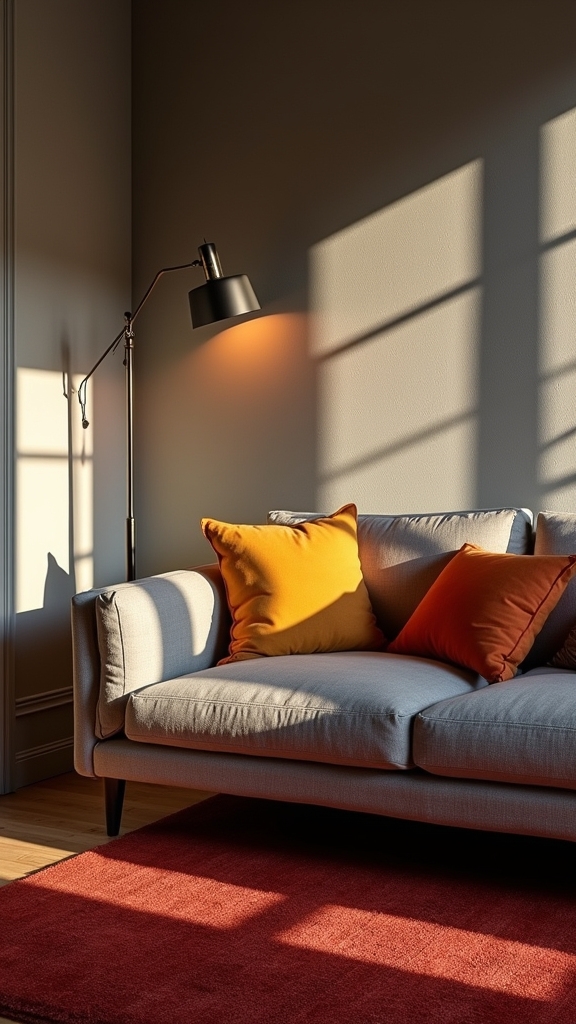
While grey is often perceived as a cool or austere choice for living room design, the integration of warm lighting can dramatically transform the space’s atmosphere. Expertly applied warm lighting infuses a cozy atmosphere, counteracting any sense of sterility and making grey tones appear more inviting. Soft ambient lighting—achieved through dimmable fixtures—allows for nuanced control, shifting the mood to suit various occasions. Employing layered lighting, such as table and floor lamps, not only guarantees functional illumination but also serves to highlight textures and create visual hierarchy within the room. The strategic placement of warm light sources establishes focal points, drawing attention to art, architectural features, or textured surfaces. This approach adds depth and visual interest, enriching the overall design narrative of a grey living room. Incorporating energy-efficient lighting options like LED bulbs can further enhance the living room’s ambiance while promoting sustainability.
Combine Grey With Natural Materials
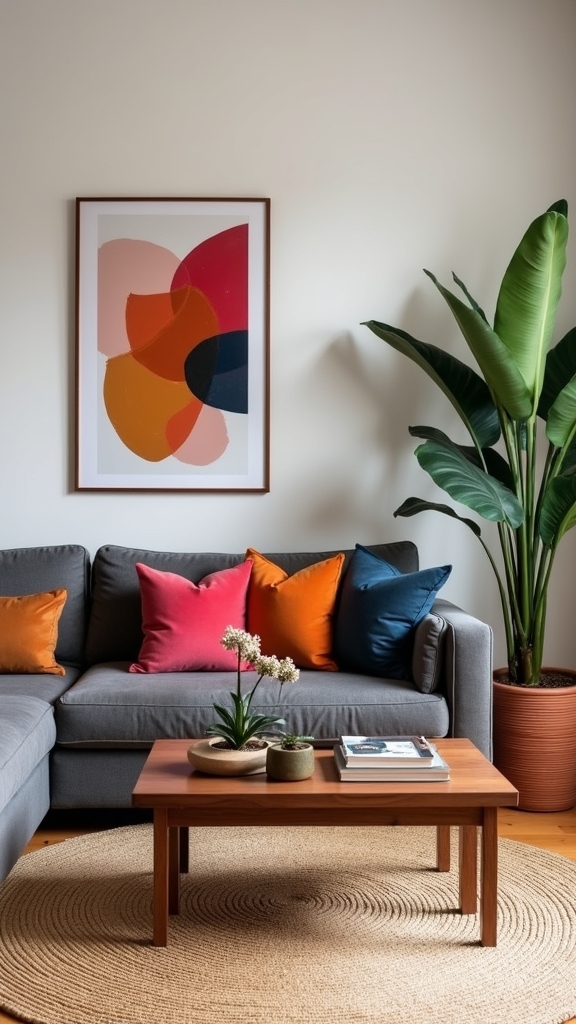
Pairing grey with natural wood introduces warmth and visual grounding to the living room, offsetting cool undertones with organic richness. Layering a variety of textures—such as tactile jute rugs, linen textiles, and stone accents—enhances depth and comfort within the palette. This approach guarantees the space remains inviting and balanced, preventing a sterile or overly monochromatic effect. Incorporating houseplants to balance the grey decor adds a touch of nature and further enriches the aesthetic, making the space more dynamic and lively.
Pair Grey With Wood
Many contemporary living rooms benefit from the interplay between cool grey palettes and the organic warmth of natural wood. The juxtaposition of grey walls or furnishings with wood accents introduces an earthy, harmonious balance, elevating the overall aesthetic.
Lighter woods—such as oak or birch—soften the space and add warmth, while richer tones like walnut inject sophisticated contrast. Textured wood elements, including exposed beams or bespoke shelving, create visual interest and depth, ensuring the room avoids monotony.
Designers recommend integrating natural materials through carefully selected accessories, such as wooden picture frames or artisanal bowls, to enhance the organic ambiance. This approach aligns with modern trends that prioritize natural materials, resulting in a grey living room that feels both serene and visually compelling.
Layer Textures for Warmth
Texture plays a pivotal role in transforming grey living rooms from stark to inviting, particularly when natural materials are thoughtfully integrated.
Layering textures—through elements like wool throws, velvet cushions, and shaggy rugs—introduces both warmth and visual depth to the space. Incorporating natural materials such as wood, stone, and textiles made from cotton or jute further enhances a cozy atmosphere, preventing the grey living room from appearing flat or sterile.
Strategically placed wooden furniture balances the softness of fabric with tactile contrast, adding an inviting touch. For ideal results, mixing soft furnishings in varied weaves and finishes personalizes the environment while maintaining cohesion.
This expert approach to layering textures guarantees the grey living room exudes both comfort and dynamic interest.
Follow the 60-30-10 Colour Rule
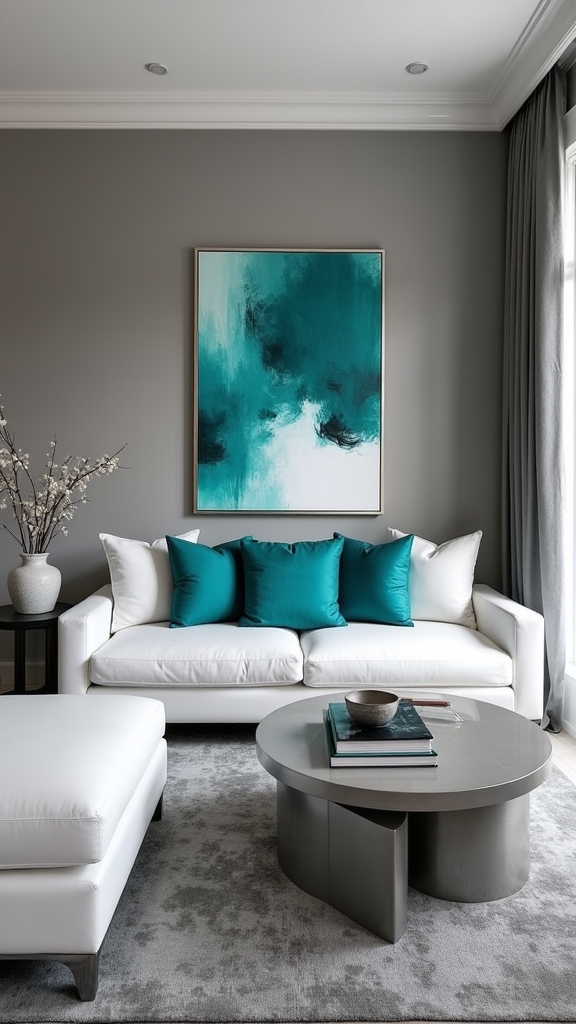
When designing a grey living room, adhering to the 60-30-10 colour rule provides a reliable framework for achieving visual balance and sophistication. In this scheme, grey serves as the dominant colour, covering approximately 60% of the space—think walls, large furniture, or rugs—establishing a cohesive and harmonious backdrop. The secondary colour, comprising 30%, should complement the grey, enhancing the overall aesthetic without overwhelming the palette. This could include muted blues, deep greens, or jewel tones strategically applied through curtains or accent chairs. The final 10% is reserved for an accent colour, chosen to inject visual interest and energy—such as bold cushions or artwork. Incorporating bold accent pieces like a deep red sofa can create a dramatic visual impact, breaking the monotony and adding personality to the room. This approach enables personal expression while ensuring the colour scheme remains unified and visually appealing throughout the room.
Warm up Grey With Earthy Tones
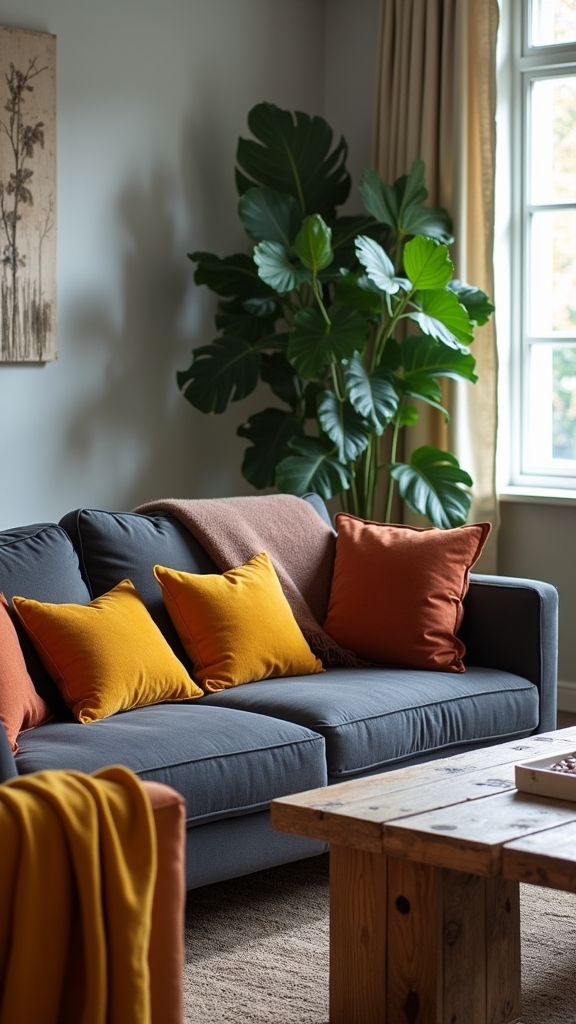
Although grey provides a sleek and versatile foundation for living room design, integrating earthy tones such as beige, brown, and muted greens introduces warmth and depth essential for a welcoming ambiance. Warm tones, when paired with cool greys, help to create a cozy, inviting atmosphere that feels both contemporary and timeless. Incorporating tan leather sofas or reclaimed wood tables infuses natural texture and richness, while accent pieces like terracotta vases and woven baskets reinforce cohesion within the grey living room. Earthy tones enhance visual interest and soften the overall aesthetic, ensuring the space feels grounded rather than stark. This balanced color palette is especially effective in organic-inspired interiors, offering harmony and comfort without overwhelming the senses. Thoughtful layering of these elements promotes a visually unified, welcoming environment. Incorporating wooden furniture like farmhouse tables can add warmth and charm while celebrating natural beauty and durability within the space.
Choose Your Grey Based on Room Orientation
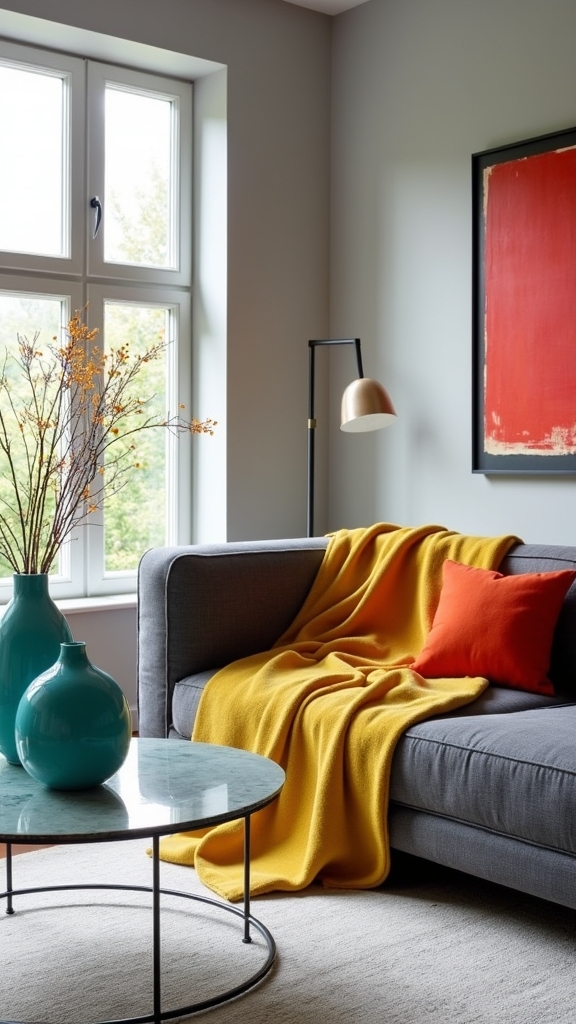
Beyond incorporating earthy accents, the success of a grey living room hinges on selecting the right shade in response to the room’s orientation. Room orientation dictates the quality and quantity of natural light, which profoundly impacts how grey shades are perceived throughout the day.
To choose the right shade, consider the following expert strategies:
- Southern-facing rooms: Abundant natural light allows flexibility; both light and darker grey shades maintain vibrancy.
- North-facing rooms: Limited sunlight makes darker grey ideal for fostering a cozy atmosphere and counteracting cool undertones.
- East-facing rooms: Morning light complements soft greys, producing a gentle and inviting effect.
- West-facing rooms: Warmer greys balance the intensity of evening light, guaranteeing the room avoids feeling overly cool.
Strategically matching grey to orientation guarantees visual harmony and comfort. Integrate sleek leather and plush velvet for textural contrast to further enhance the appeal of a grey living room design.
Try Greige for a Softer Neutral Look
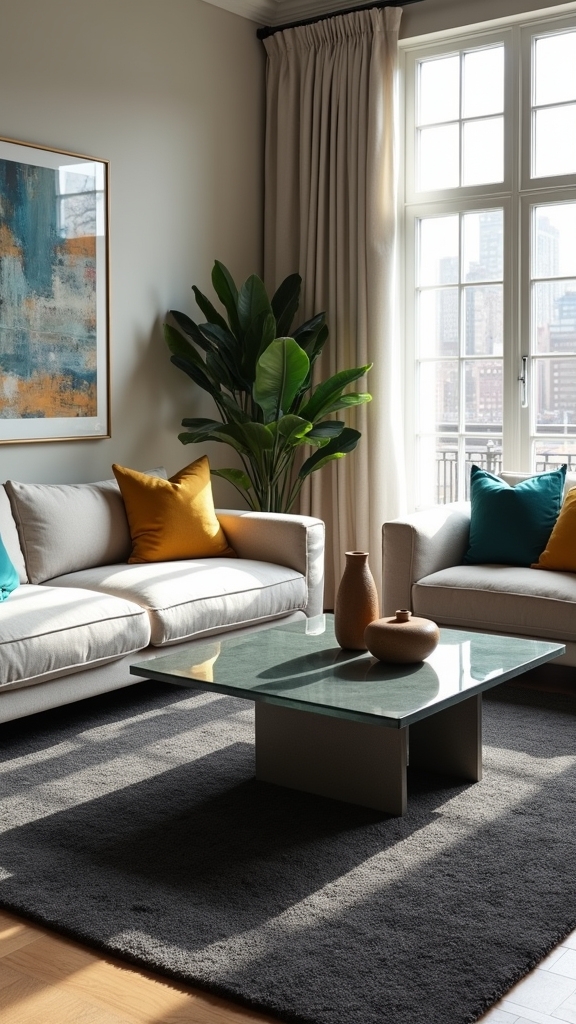
Greige, with its subtle balance of grey and beige undertones, introduces warmth to the living room palette while maintaining a refined neutrality.
This adaptable hue serves as an ideal foundation for layering both vivid and muted accents, supporting a range of design aesthetics.
For practical application, consider greige in large-scale elements such as walls or sofas to achieve a cohesive, versatile backdrop that invites personalized styling.
Warm Up Your Palette
Many contemporary designers recommend greige—a nuanced fusion of grey and beige—as a strategic choice for softening living room palettes.
This warm neutral injects subtle warmth compared to classic grey, establishing a cozy atmosphere without sacrificing modernity. Greige plays well with earthy tones, such as muted greens and browns, amplifying an inviting feel while maintaining refined sophistication.
For ideal effect, designers propose layering greige across various elements:
- Apply greige to larger items like sofas or walls to avoid a stark or cold effect.
- Combine with earthy tones in accent pieces to foster visual interest and harmonious depth.
- Integrate greige in soft furnishings—cushions, throws, rugs—to soften the overall look.
- Use greige backdrops to enhance the perception of space and comfort.
Greige for Versatile Styling
When aiming to achieve a softer neutral look in the living room, greige emerges as a highly adaptable foundation that seamlessly bridges cool and warm undertones. This versatile hue—an elegant blend of grey and beige—offers a warm neutral backdrop ideal for a sophisticated aesthetic. Greige excels in various lighting conditions, enhancing an inviting atmosphere and encouraging the layering of textures and accent colors. Pairing greige with earthy tones such as muted greens or terracotta reinforces a sense of comfort, while bold accent colors can be introduced for dynamic visual interest. Larger furnishings or wall treatments in greige prevent flatness, creating depth and flexibility in styling.
| Greige Feature | Visual Impact | Styling Tip |
|---|---|---|
| Warm neutral base | Soft, inviting glow | Pair with earthy tones |
| Versatile for lighting | Consistent appearance | Use on walls or large sofas |
| Supports accent colors | Dynamic interest | Layer with vibrant cushions |
| Sophisticated aesthetic | Timeless elegance | Incorporate metallic accents |
| Enhances textures | Multi-dimensional | Mix natural fibers and woods |
Layer Different Shades and Textures of Grey
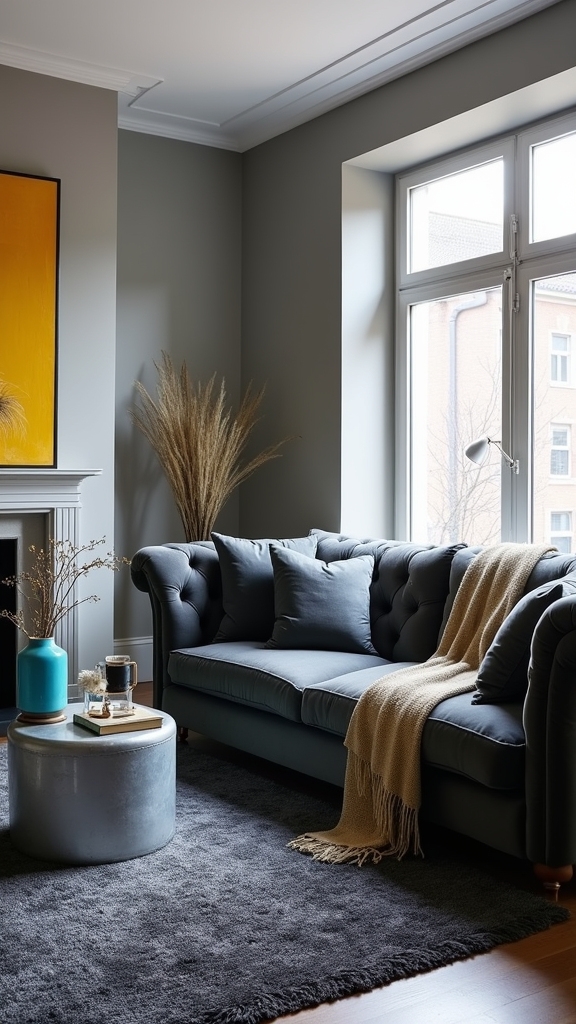
Although a monochromatic palette risks appearing flat, layering a spectrum of grey tones—ranging from light and airy to deep charcoal—establishes both depth and visual intrigue in a living room.
Strategic layering shades of grey not only enhances depth and dimension but also introduces a sophisticated interplay of light and shadow.
Layering varied shades of grey brings depth and dimension, creating a refined play of light and shadow in any space.
For expert results, designers recommend the following:
- Use light airy greys for expansive surfaces such as walls to serve as a neutral, versatile backdrop.
- Integrate medium greys like dove or slate in upholstery or rugs to subtly anchor the space.
- Employ darker shades, such as charcoal, on accent pieces to heighten visual interest and create focal points.
- Enhance comfort and a cohesive look by mixing textures—combine velvet cushions, wool throws, and metal or wood accents.
Adding natural elements such as potted plants or vertical gardens can also soften the monochrome palette and introduce a touch of warmth and life.
Limit Grey to Key Furniture Pieces

A select number of key furniture pieces in grey—such as a sofa, armchair, or coffee table—establish a versatile and understated foundation within the living room. This strategic use of a grey sofa and grey coffee table creates a neutral backdrop that prevents the space from becoming visually flat or monotonous. By anchoring the decor with these core elements, homeowners can introduce vibrant accent colors through cushions, rugs, or art, generating visual interest and dynamic contrast. The integration of warm earth tones or bold jewel shades in accessories guarantees the environment feels balanced and inviting rather than cold. Adding elements like warm yellows and mustard can create a cozy glow, enhancing the ambiance and uplifting the mood. This approach also allows for seasonal flexibility, as colorful accents may be refreshed to suit evolving tastes, maintaining an energetic and engaging atmosphere without extensive redesign.
Add Contrast With Black and Metallic Accents
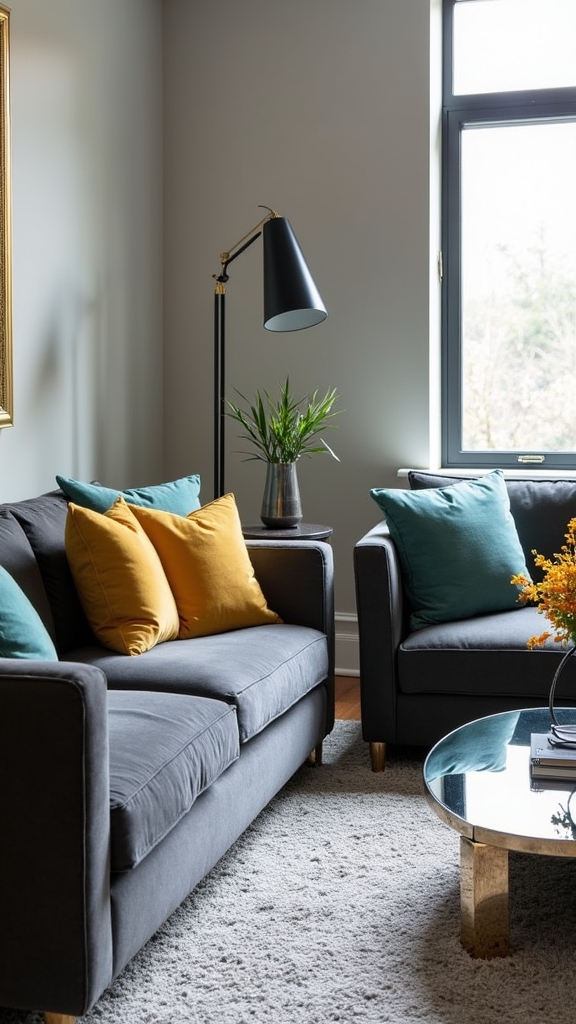
Building on a foundation of grey furniture, introducing black and metallic accents enhances the living room’s visual hierarchy and sophistication.
Black accents inject a modern edge and striking contrast, cultivating visual interest while sustaining a sophisticated balance within grey interiors. Simultaneously, metallic accents—such as gold, brass, or silver—add warmth, luxury, and a subtle gleam, counterbalancing the cool undertones of grey and fostering a polished atmosphere.
For best results, consider the following expert strategies:
- Incorporate black picture frames or furniture to define architectural lines and create depth and drama.
- Select metallic accessories—vases, trays, or lamps—to reflect natural light and raise elegance.
- Combine black and metallic details for a dynamic, layered look.
- Choose mirrored surfaces to maximize light and spatial perception in grey interiors.
Energize Grey With Pops of Citrus Colour
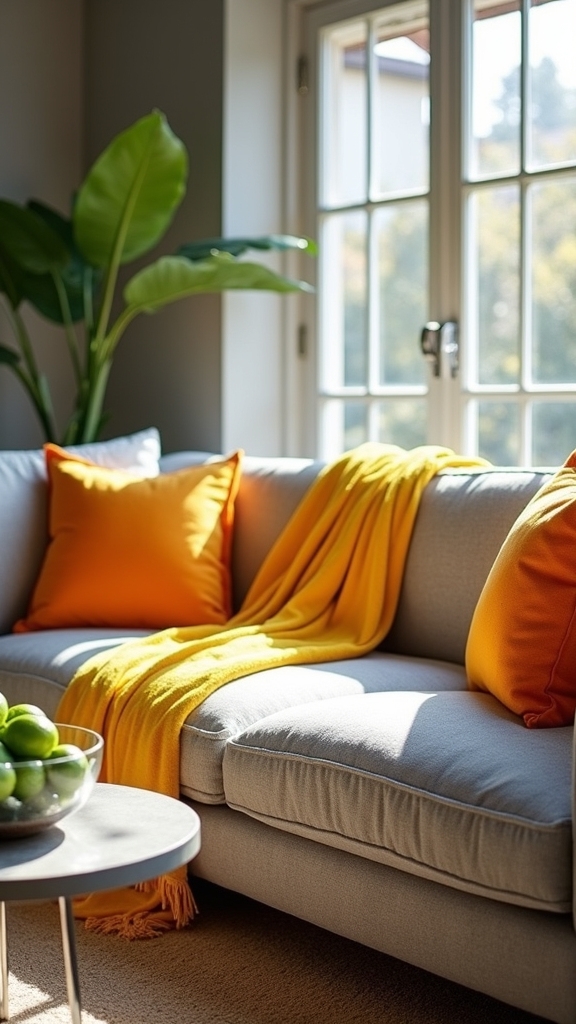
Pairing grey with yellow infuses the living room with a dynamic interplay of brightness and neutrality, while orange accents bring warmth and vibrancy to the scheme.
Strategically placed cushions, rugs, or art pieces in these citrus tones can instantly refresh a grey palette without visual overload.
For maximum impact, maintain a balance between the boldness of the accents and the serenity of the grey foundation.
Pair Grey With Yellow
Many contemporary living rooms benefit from the dynamic interplay of cool grey tones and vibrant citrus yellow accents, a combination that injects energy and visual contrast into the space.
Grey provides a versatile, sophisticated base, while yellow accents—whether in cushions, artwork, or decor—impart warmth and liveliness. This pairing aligns with design trends that favor expressive, personalized interiors.
The visual impact is heightened by varying yellow hues, from subtle pastels to bold, vibrant tones, layered against the neutrality of grey.
- Use yellow cushions or throws to create focal points and enliven grey seating.
- Incorporate yellow artwork or decorative objects for a curated, modern decor statement.
- Layer multiple shades of yellow for depth and dynamic contrast.
- Maintain balance by distributing yellow accents evenly throughout the space.
Use Orange Accents
Citrus-inspired orange accents introduce a burst of vibrancy to a grey living room, delivering immediate visual contrast and a sense of warmth.
Strategically placed orange cushions, throws, or statement artwork energize the neutral backdrop, creating dynamic visual interest without overpowering the space.
Orange accents harmonize with cool grey tones, striking a balance between warmth and sophistication and cultivating an inviting atmosphere.
For a cohesive look, select varying shades and patterns of orange that complement the specific grey palette, ensuring a unified design scheme.
Rotate orange elements seasonally—such as vases, textiles, or decorative objects—to keep the color palette fresh and dynamic.
This approach maintains flexibility while consistently injecting energy, making the grey living room feel both contemporary and welcoming throughout the year.
Highlight Grey With Bold Art and Accessories
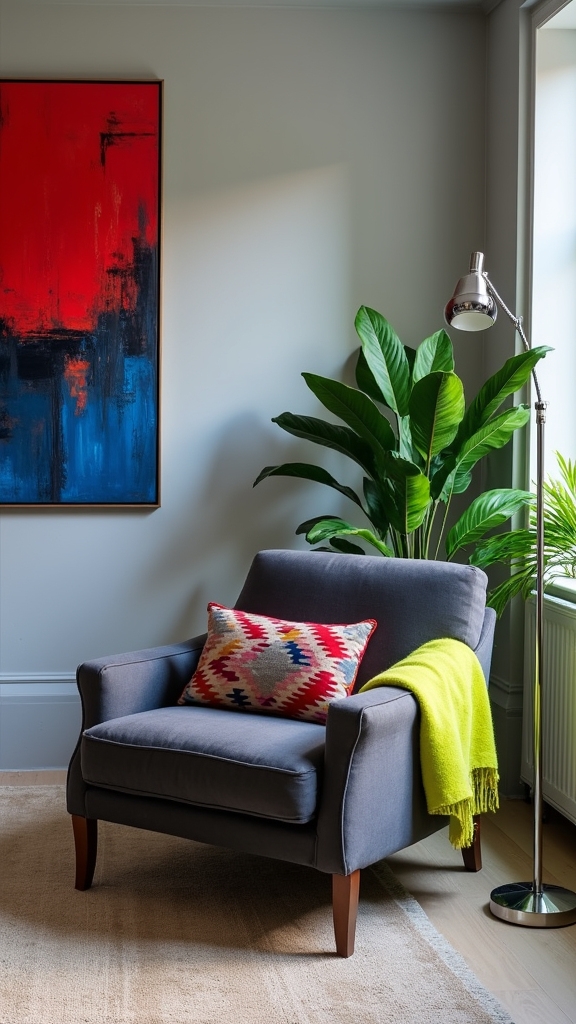
Infuse vibrancy into a grey living room by introducing bold artwork and statement accessories that punctuate the neutral palette.
Strategically placed elements in vibrant colors generate visual interest and enliven the overall design. To enhance the aesthetic and maintain a cohesive look, consider the following expert techniques:
- Display bold artwork with dynamic patterns and saturated hues to create a focal point against grey walls.
- Integrate colorful cushions, throws, and patterned vases to inject energy and allow for easy seasonal updates.
- Incorporate metallic accents—such as gold, brass, or chrome—in lighting or decor objects for a sophisticated, glamorous layer.
- Layer various textures and patterns through textiles and art to add dimension, ensuring the scheme feels playful yet coordinated.
This multidimensional approach revitalizes grey spaces.
Frequently Asked Questions
How Do You Add Warmth to a Grey Living Room?
To add warmth, a designer integrates earthy tones and warm accents, employs textured fabrics, layered rugs, and cozy throws, incorporates natural elements, selects soft lighting, and introduces bright artwork, ensuring visual depth and inviting comfort within the grey living room.
What Color Compliments a Grey Living Room?
When selecting a color to complement a grey living room, experts recommend integrating charcoal accents, pastel hues, vibrant artwork, warm textiles, natural elements, bold patterns, metallic finishes, and earth tones to create visual depth, balanced contrast, and inviting ambiance.
How to Make a Grey Living Room Look Cosy?
To create a cozy living room, experts recommend layering rugs, using cozy textiles, and adding soft cushions with decorative throws. Incorporating warm lighting, vibrant artwork, inviting scents, and natural elements visually enhances comfort and fosters an inviting ambiance.
What Colors Compliment Grey the Most?
When considering what colors complement grey most effectively, designers recommend bold accents, soft pastels, earthy tones, jewel hues, and warm neutrals. Monochromatic schemes, metallic touches, and natural greens further enhance visual interest and create a sophisticated, balanced palette.
Conclusion
In conclusion, grey living rooms offer a sophisticated foundation for dynamic design. By layering tactile soft furnishings, introducing vibrant accent colors, and strategically using natural materials and metallics, homeowners can prevent grey from feeling flat or cold. Warm lighting and bold artwork further amplify visual interest. Thoughtful integration of these elements guarantees the space remains both inviting and on-trend, balancing timeless elegance with contemporary energy for a living room that is as stylish as it is livable.
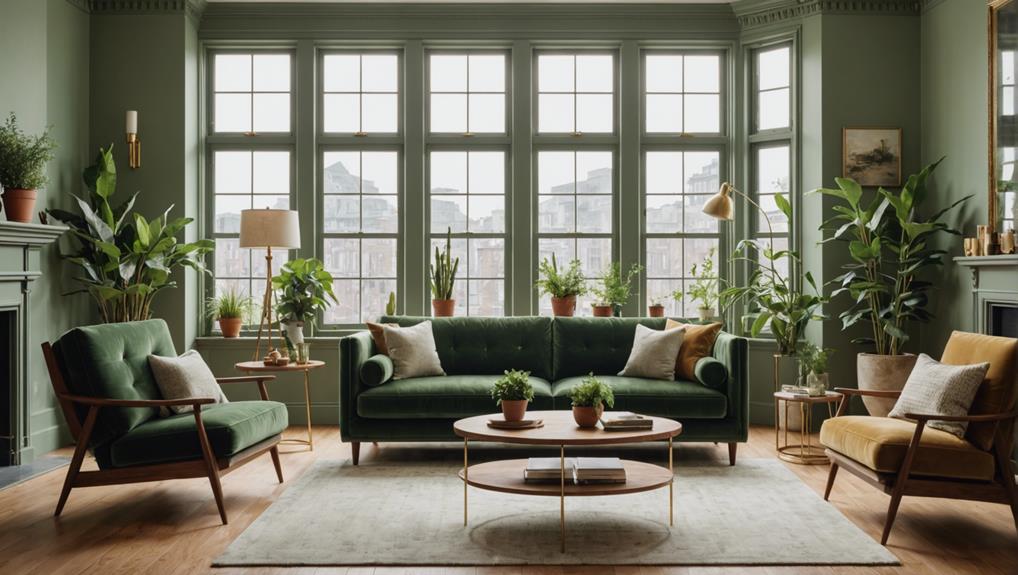
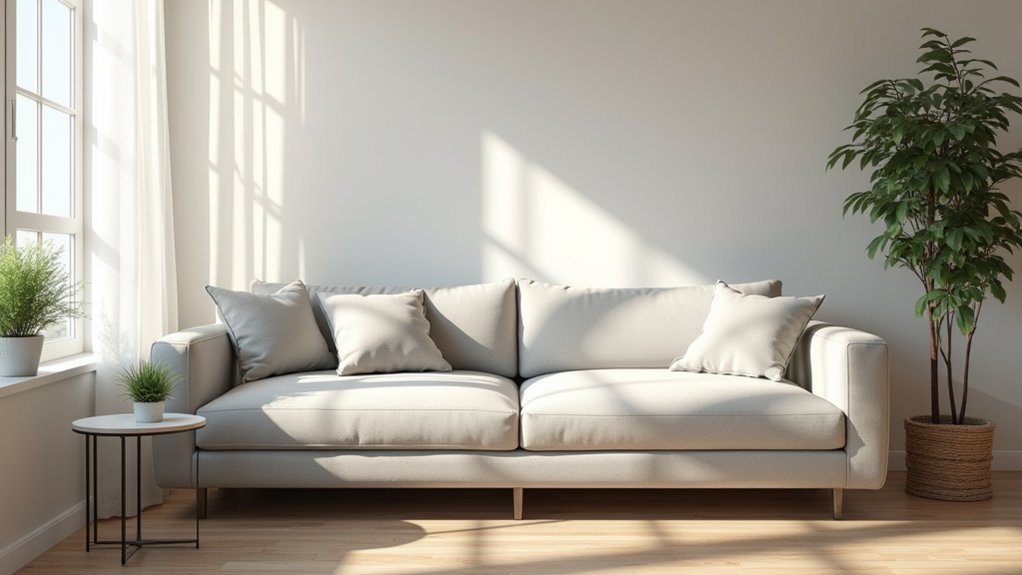
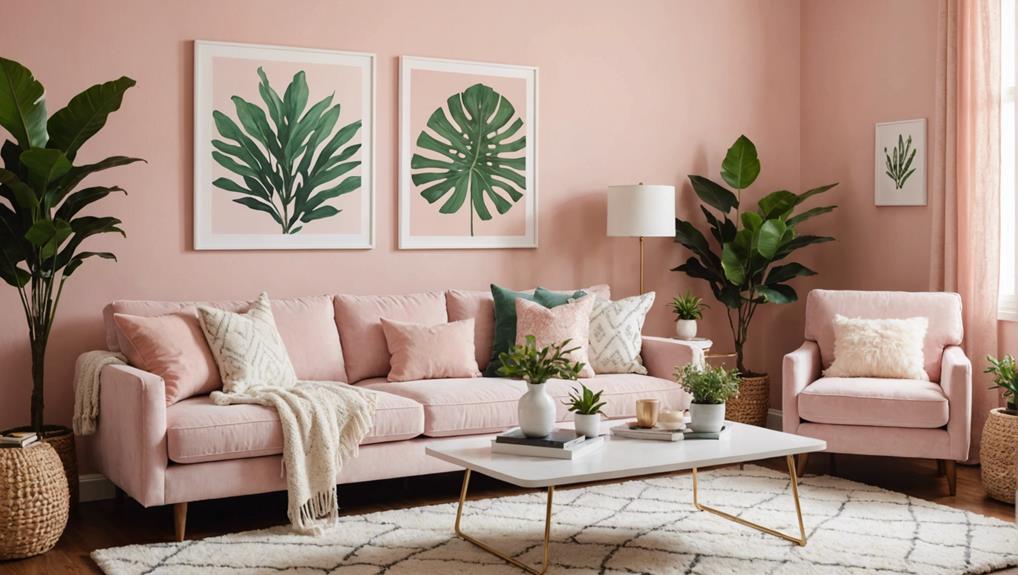
Leave a Reply